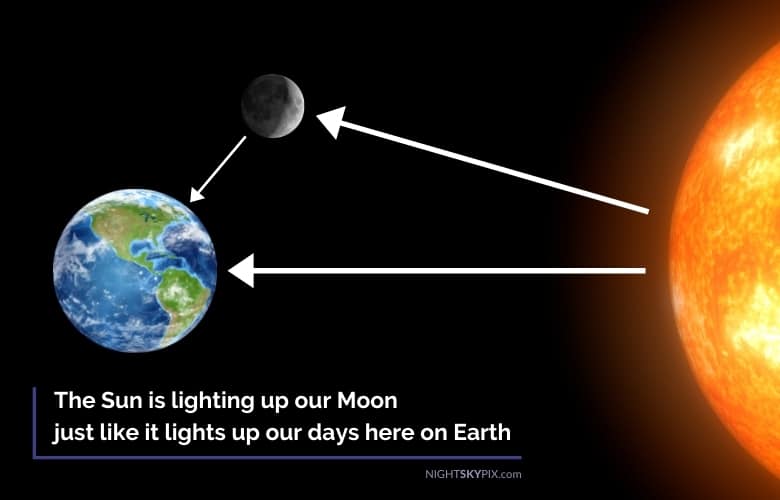Welcome to Learn to Astronomy! In this article, we will explore the fascinating question: what makes the moon shine? Join us as we delve into the celestial mechanics and uncover the scientific secrets behind the moon’s radiant glow. Get ready to embark on an enlightening journey through the cosmos!
The Moon’s Luminosity: Unveiling the Secrets Behind its Radiant Glow
The Moon shines brightly in the night sky, captivating our attention and sparking our curiosity. While it may appear to emit its own light, the Moon is actually reflecting sunlight that illuminates its surface. This phenomenon is known as the Moon’s luminosity.
The luminosity of the Moon varies throughout its different phases. During a full moon, when the Moon is positioned directly opposite the Sun, its entire face is visible and it appears at its brightest. Conversely, during a new moon, when the Moon is positioned between the Earth and the Sun, its illuminated side faces away from us, resulting in a dark appearance.
The Moon’s luminosity is influenced by its albedo, which is the amount of sunlight it reflects. The lunar surface is covered in regolith, a layer of fine dust and debris that has accumulated over billions of years. This regolith contains various minerals that can scatter and reflect sunlight, contributing to the Moon’s overall brightness.
Another factor that affects the Moon’s luminosity is its distance from the Earth. As the Moon orbits around our planet, its distance changes, leading to variations in its apparent size and brightness. When the Moon is closest to the Earth, a phenomenon known as a supermoon occurs, where the Moon appears larger and brighter than usual.
Understanding the Moon’s luminosity is crucial for astronomers, as it impacts their observations and studies of celestial objects. By studying the Moon’s reflective properties, scientists can gain insights into the composition of its surface and better understand its formation and evolution.
In conclusion, the Moon’s luminosity is a captivating phenomenon that stems from its ability to reflect sunlight. Factors such as the Moon’s phase, albedo, and proximity to the Earth all play a role in determining its radiant glow in the night sky. Continued exploration and research into the Moon’s luminosity will undoubtedly unveil further secrets about our closest celestial neighbor.
Why There Is Light on Earth But Not in Space
[arve url=”https://www.youtube.com/embed/J1Fxl4cGVd4″/]
The Moon Is Not What You Think It Is!
[arve url=”https://www.youtube.com/embed/st_-N8JKYHM”/]
Frequent questions
What causes the moon to shine at night?
The moon shines at night because it reflects sunlight. Unlike the sun, which is a source of light itself, the moon does not have its own light source. Instead, it reflects the light that it receives from the sun. When sunlight hits the moon’s surface, it bounces off and travels towards Earth. This reflected light is what makes the moon appear bright and shine in the night sky.
The amount of light reflected by the moon varies depending on its phase. For example, during a full moon, the entire face of the moon is illuminated by the sun, resulting in a bright and shiny appearance.
How does the moon reflect sunlight to create its luminosity?
The moon reflects sunlight to create its luminosity through a process called lunar reflection. When sunlight reaches the moon, it interacts with its surface. The moon’s surface is covered in a layer of fine dust particles and rocky material called regolith. These particles have different sizes and compositions, which affects how they reflect light.
When sunlight hits the moon’s surface, some of it gets absorbed, while the rest undergoes scattering and reflection. The regolith acts as a diffusing surface, scattering the sunlight in all directions. This scattering process causes the sunlight to bounce off the moon’s surface in various directions.
The different angles at which the sunlight reflects off the moon’s surface determine the moon’s luminosity or brightness that we observe from Earth. When the moon is in its full phase, it appears brightest because the sunlight directly illuminates the entire visible side of the moon facing Earth. As the moon moves through its phases, the angle at which sunlight reflects off its surface decreases, resulting in different levels of illumination seen from Earth.
It’s important to note that the moon does not produce its own light; it only reflects sunlight. This reflection is what allows us to see the moon and its phases from Earth. By studying the lunar reflection, astronomers can gain valuable insights into the composition and properties of the moon’s surface.
Can the moon produce its own light, or does it solely rely on reflecting sunlight to shine?
The moon does not produce its own light. It solely relies on reflecting sunlight to shine. The moon’s surface reflects the sunlight that falls on it, which is why we see it as a bright object in the night sky. This reflection is what allows us to see the moon, especially during the phases when it appears fully illuminated (full moon).
In conclusion, understanding the phenomenon of what makes the moon shine is crucial in the field of Astronomy. The moon’s brightness is not a result of its own light, but rather a reflection of sunlight bouncing off its surface. This illuminating effect stems from the moon’s lack of atmosphere and its highly reflective composition.
As the Earth orbits the Sun, the moon goes through different phases, altering its position and the amount of sunlight that reaches it. These changes create the mesmerizing spectacle we observe each night. Studying the moon’s shine helps scientists unravel important information about its geological makeup, composition, and history.
Furthermore, understanding the moon’s brightness allows us to appreciate its beauty and harness the benefits it provides, such as aiding navigational purposes and inspiring artistic creations. Ultimately, delving into the intricacies of what makes the moon shine amplifies our knowledge about our celestial companion and enhances our appreciation for the wonders of the cosmos.

